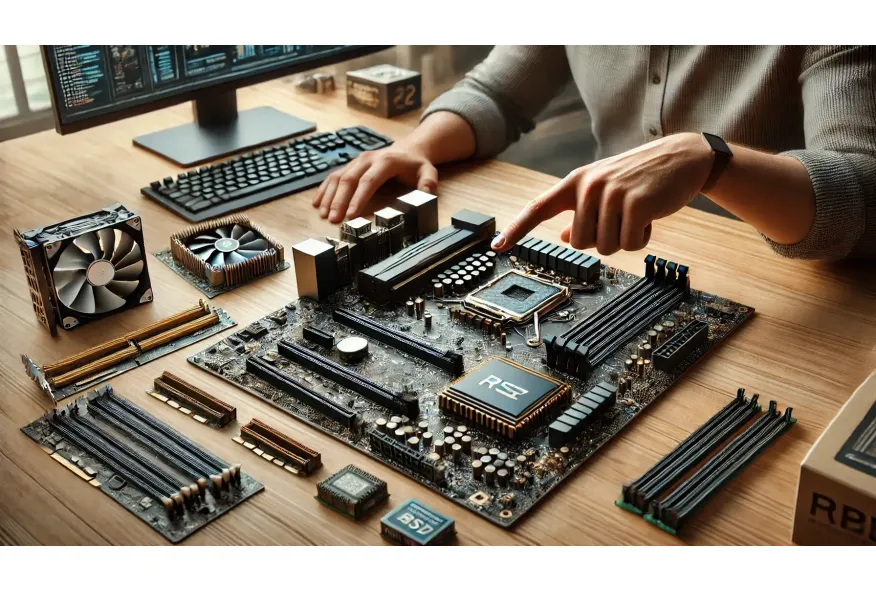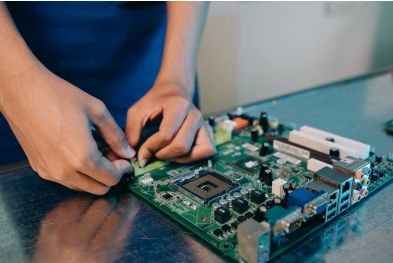How to Choose the Best Motherboard for Your PC
Choosing the right motherboard is one of the most important steps when building a PC. It serves as the backbone of your system, connecting all components, including the processor, RAM, graphics card, and storage devices. Selecting the wrong motherboard can limit your upgrade options or cause compatibility issues.
In this guide, we’ll walk you through everything you need to know about choosing the best motherboard for your build.
1. Understanding Motherboard Basics
A motherboard is a circuit board that allows all your computer’s components to communicate. When choosing one, you need to consider its form factor, socket type, chipset, connectivity options, and expansion capabilities.
2. Choosing the Right Form Factor
Motherboards come in different sizes, also known as form factors. The three most common ones are:
| Form Factor | Size (Approx.) | Features | Use Case |
|---|---|---|---|
| ATX | 12 x 9.6 inches | Most expansion slots and features | Best for high-end builds |
| Micro-ATX | 9.6 x 9.6 inches | Fewer expansion slots, more compact | Good for mid-range builds |
| Mini-ITX | 6.7 x 6.7 inches | Compact, limited slots | Best for small form factor builds |
If you want more expansion slots for multiple graphics cards, sound cards, or additional storage, go with ATX. If you're building a small, compact PC, Mini-ITX is ideal.
3. CPU Socket and Compatibility
Your motherboard must be compatible with your CPU brand and model.
- Intel sockets: LGA 1700 (for 12th/13th/14th Gen Intel Core), LGA 1200 (for 10th/11th Gen).
- AMD sockets: AM4 (for Ryzen 1000-5000 series), AM5 (for Ryzen 7000 and newer).
If you buy an Intel Core i7-13700K, for example, you need an LGA 1700 motherboard. If you get an AMD Ryzen 7 7800X3D, you’ll need an AM5 motherboard.
4. Chipset: The Brain of Your Motherboard
The chipset determines how well your motherboard performs and which features it supports.
Intel Chipsets (For 12th-14th Gen Processors)
| Chipset | Features | Best For |
|---|---|---|
| Z790 | Overclocking, multiple PCIe lanes, high-end features | Enthusiasts, gamers |
| B760 | Good balance of price and features | Mid-range users |
| H770 | Similar to B760, with more PCIe lanes | Power users |
| H610 | Budget-friendly, limited features | Office and basic builds |
AMD Chipsets (For Ryzen Processors)
| Chipset | Features | Best For |
|---|---|---|
| X670E | Overclocking, PCIe 5.0, high-end features | Enthusiasts |
| B650 | PCIe 5.0 for SSDs, solid performance | Mid-range users |
| A620 | Budget-friendly, fewer PCIe lanes | Basic users |
If you plan to overclock your CPU, make sure to choose a motherboard with an overclocking-capable chipset (e.g., Intel Z790 or AMD X670E).
5. RAM Compatibility and Slots
Motherboards support different types and amounts of RAM (memory).
- Check RAM type: DDR4 or DDR5 (they are not interchangeable).
- Check max RAM capacity: Most motherboards support 32GB-128GB.
- Check RAM slots: ATX and Micro-ATX typically have four slots, Mini-ITX usually has two.
For gaming and multitasking, 16GB (2x8GB) DDR5 is a great starting point. If you run memory-heavy tasks (video editing, 3D modeling), go for 32GB or more.
6. Expansion Slots and Connectivity
Your motherboard needs enough PCIe slots for your graphics card, SSDs, and expansion cards.
PCIe Slots
- PCIe x16: Used for graphics cards.
- PCIe x4 and x1: Used for expansion cards like Wi-Fi adapters, capture cards, or additional storage.
If you're building a gaming PC with a single GPU, a motherboard with one PCIe x16 slot is enough. But if you want multiple GPUs or extra storage cards, look for a board with multiple PCIe slots.
7. Storage Options: SATA vs. NVMe SSDs
Your motherboard must have enough SATA and NVMe (M.2) slots for your storage needs.
| Storage Type | Speed | Use Case |
|---|---|---|
| SATA SSD | ~550MB/s | Budget storage, larger capacity |
| NVMe SSD (PCIe 3.0) | ~3,500MB/s | Fast storage, ideal for gaming |
| NVMe SSD (PCIe 4.0/5.0) | ~7,000MB/s | High-performance, expensive |
For best performance, choose a PCIe 4.0 NVMe SSD if your motherboard supports it.
8. Rear I/O Ports and Connectivity
Check the ports on your motherboard to ensure it has what you need.
USB Ports
- USB 3.2 Gen 2 (10Gbps): Good for external storage and fast transfers.
- USB Type-C: Useful for newer peripherals and fast charging.
- USB 2.0: Slower, but still used for keyboards and mice.
Networking
- Ethernet: Most motherboards have 1Gbps Ethernet, but high-end models offer 2.5Gbps or even 10Gbps.
- Wi-Fi: If you need wireless internet, get a motherboard with Wi-Fi 6 or Wi-Fi 6E.
Audio Ports
If you use high-quality headphones or speakers, check for high-end audio chipsets (e.g., Realtek ALC1220).
9. RGB and Aesthetic Features
Some motherboards come with built-in RGB lighting, reinforced PCIe slots, and stylish heatsinks. If you're building a gaming setup, these can enhance your PC’s look.
If you want RGB control, check for ARGB headers on the motherboard to sync lighting with fans and accessories.
10. Budget and Best Motherboards to Buy
Best Budget Motherboards
- Intel: MSI B760M PRO-VDH, ASUS PRIME B660M-A
- AMD: ASRock B550M Pro4, ASUS TUF B650M-PLUS
Best Mid-Range Motherboards
- Intel: ASUS ROG STRIX B760-A, Gigabyte Z790 AORUS ELITE
- AMD: MSI MAG X670 TOMAHAWK, ASUS TUF GAMING B650-PLUS
Best High-End Motherboards
- Intel: MSI MEG Z790 ACE, ASUS ROG MAXIMUS Z790 HERO
- AMD: Gigabyte X670E AORUS XTREME, ASUS ROG CROSSHAIR X670E
Final Thoughts
Choosing the right motherboard ensures your PC runs smoothly and can be upgraded in the future. Always check CPU compatibility, RAM support, storage options, expansion slots, and connectivity features before buying.
If you're building a gaming PC, workstation, or budget-friendly system, there’s a motherboard that fits your needs. Take your time, compare specs, and make sure your motherboard can handle future upgrades.
Happy building! 🚀







